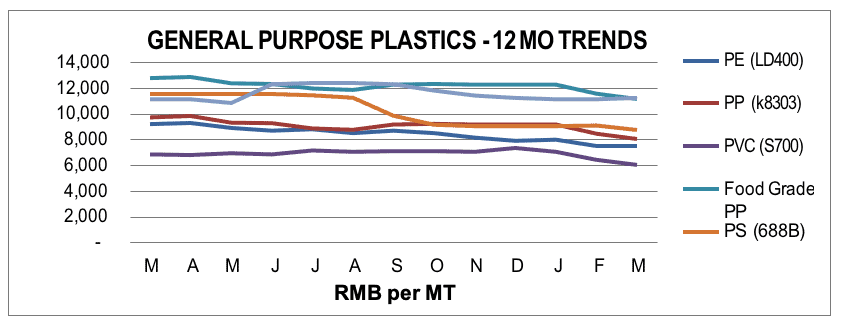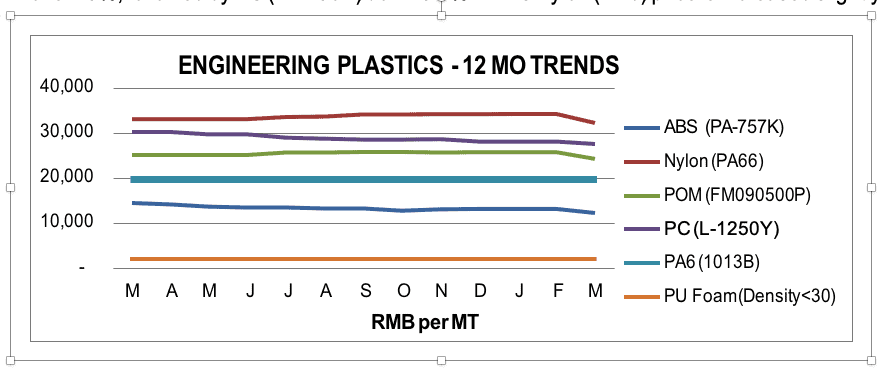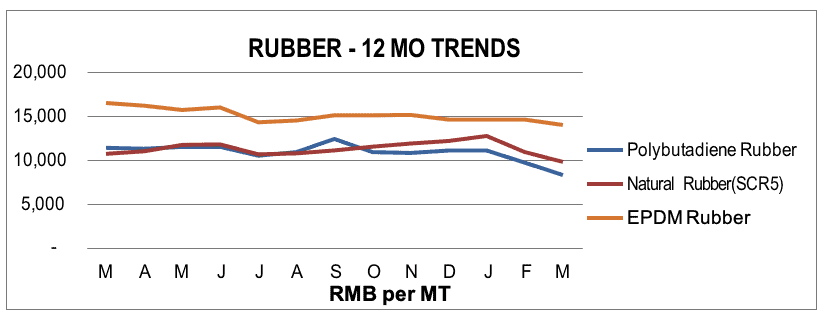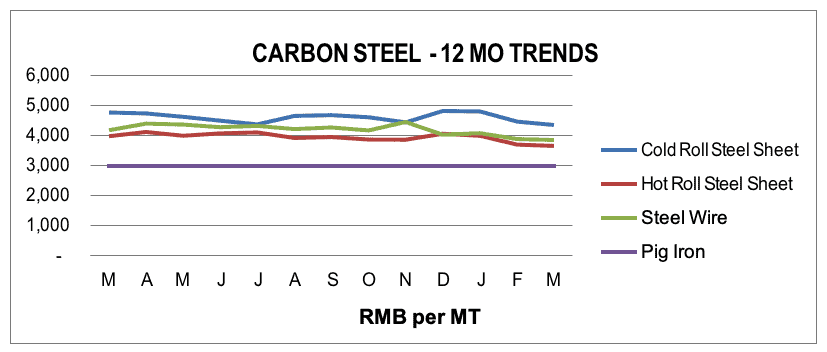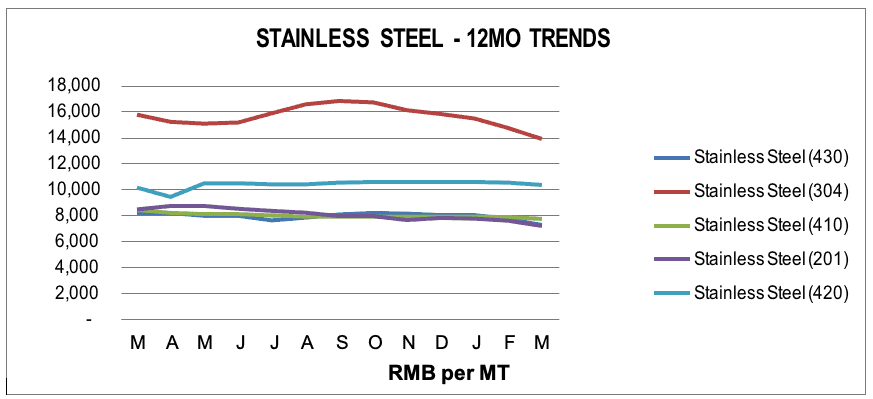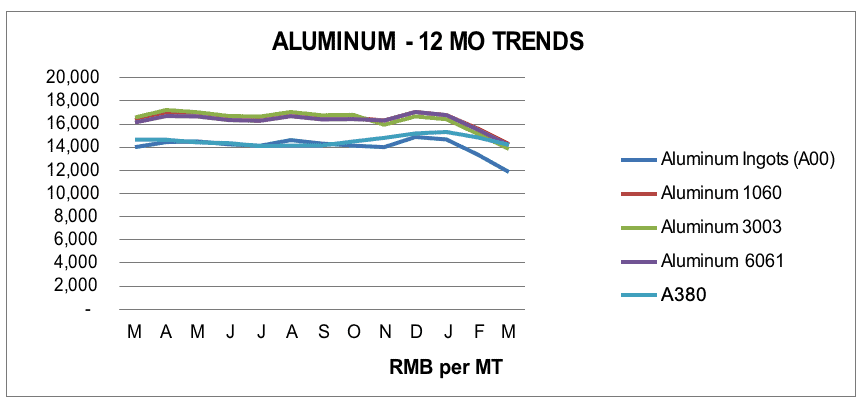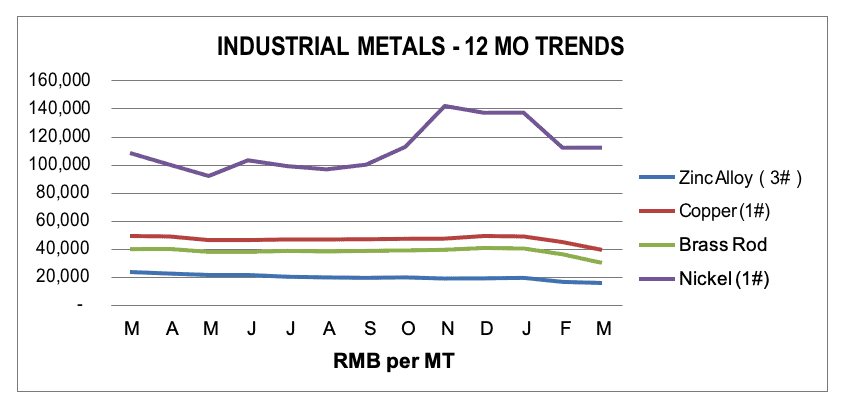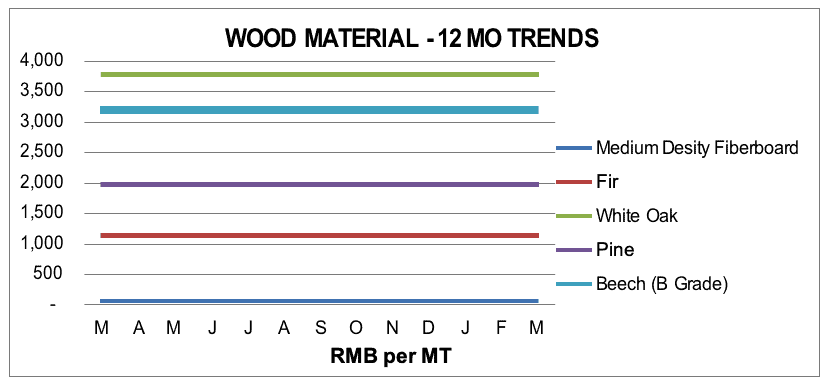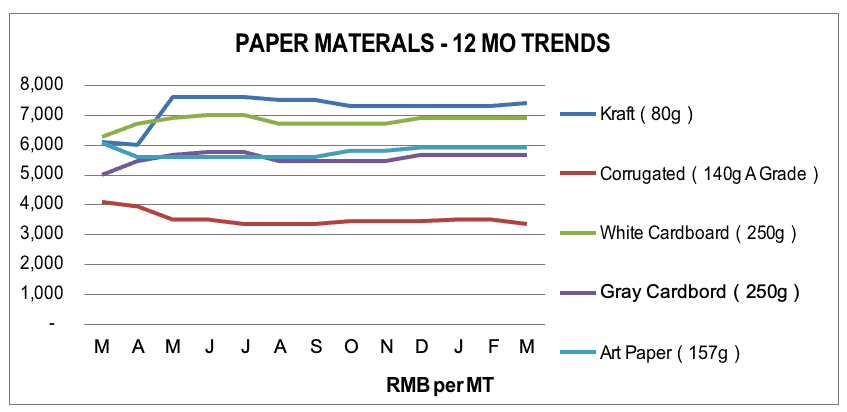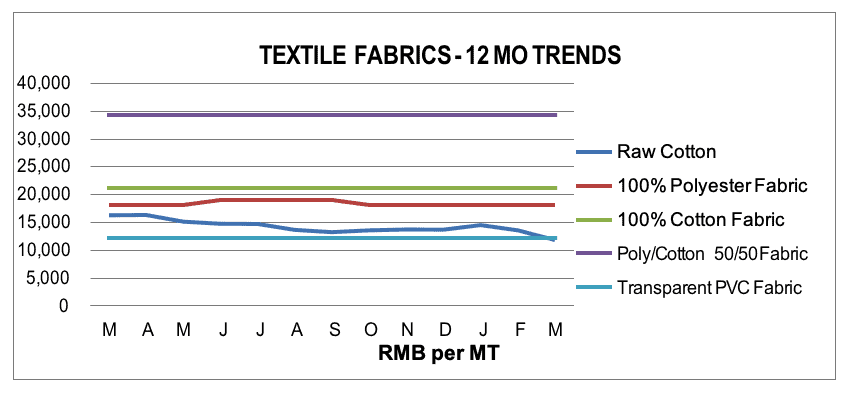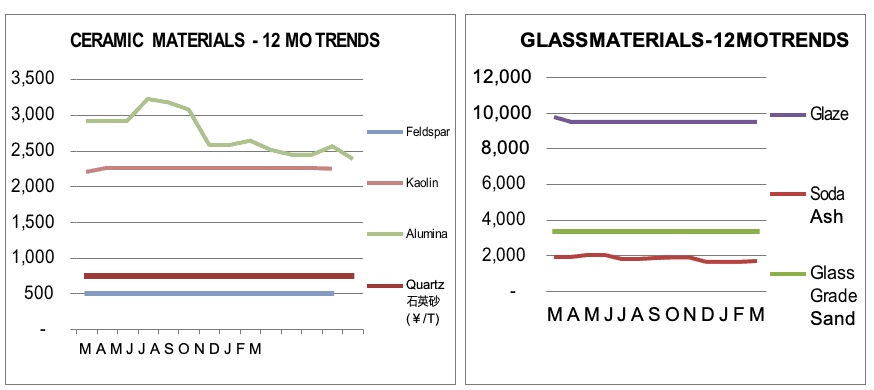Manufacturing Cost Report For First Quarter 2020
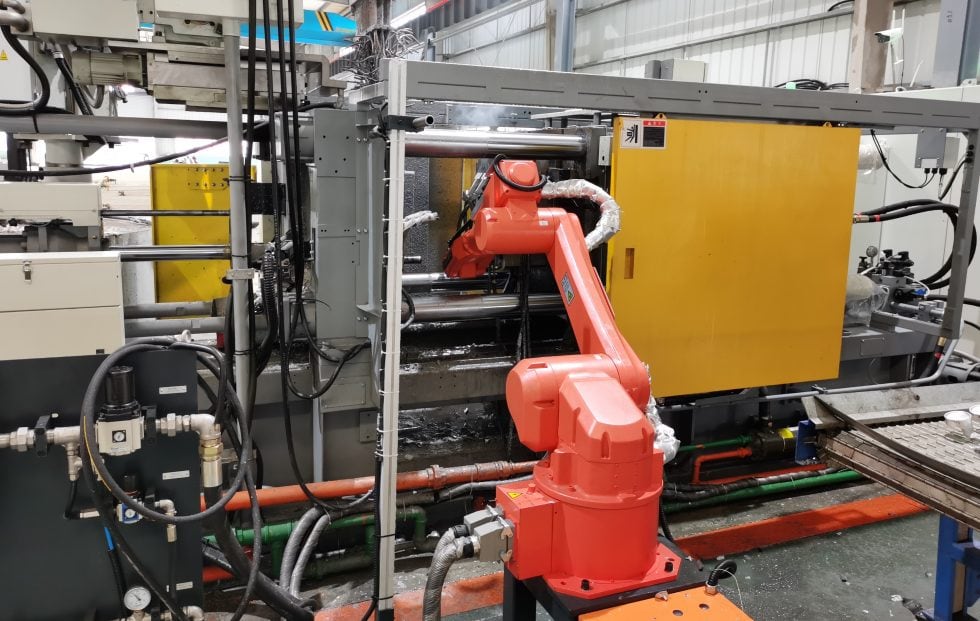
Tracking The Trends Which Drive Manufacturing Costs In Asia
In the first quarter of 2020, as a result of the impact of covid-19 virus, most commodities and manufacturing costs in the Asia region moved lower.
Manufacturing cost drivers for the entire quarter are summarized in the chart above. Leading to the decline in manufacturing costs for the first quarter of 2020 were much lower raw material prices. Most grades of Plastics, Rubber, Steel, Alum, Metals, Textiles, Ceramics and Fuel were down in price, while Wood price was flat, and only a few select grades of Paper prices went lower. Most of the Asian labor rates were unchanged in Q1 with the Lunar New Year season but some countries labor rates actually went down. The trend for World Container Index saw lower ocean freight costs while airfreight was in huge demand and was being priced on the spot market. The US Dollar remained strong against all of the Asian currencies in Q1 but, influenced by COVID-19, China imports and exports saw sharp declines in the quarter. The China CPI and PPI were also down marginally and the PMI indexes were down in February and rebounded in March. Much of China went back to work in late March with strict social distancing restrictions remaining in place.
READ ABOUT THE DETAILED ANALYSIS OF THE MANUFACTURING COST DATA
PLASTICS & RUBBER
Most of General Purpose plastic prices were down in the first quarter. Especially the price for PVC (S700) was declined over 17%. Year over year, most of the general plastic prices are down on the average of 14.6%, PS (688B) is decreased over 20%. Only PET (SE-3030) is unchanged versus one year ago.
Engineering plastic prices were down. PU Foam (Density<30) decreased marginally 1%, Nylon (PA66) and ABS (PA-757K) were down on the average of 6%, while Nylon (PA6) was unchanged. Year over year, ABS (PA-757K) is down most in price which is over 15%, followed by PC (L-1250Y) down 8.3%. While Nylon (PA6) price is increased slightly.
Rubber prices followed plastic resin down in Q1 with Polybutadiene Rubber was down most in price, over 25%, followed by Latex Rubber down almost 20%. Conversely, NBR price increased slightly 1.6% while Neoprene Rubber and Natural Rubber (SCR5) prices were unchanged. Year over year, except for Natural Rubber (SCR5) which is unchanged, most of rubber prices are down, with Polybutadiene Rubber leading the way, down over 27%, followed by EPDM price is down 15.2%.
METAL
Steel saw sharp declines as many businesses closed and project were delayed. Prices for most grades of Carbon Steel were down with Cold Roll Steel Sheet and Hot Roll Steel Sheet leadign the way down 1t 0% and 10.2% respectively, Cold Roll Steel Tube was down slightly 1.6% in price wth the raw Pig Iron holding steady. Year over year, most of carbon steels in price are down on the average 8.3% versus one year ago.
As for Stainless Steel, all of the grades of prices were down in the first quarter, with 304 down most in price, over 12%. 420 and 410 prices were down on the average of 2%. Year over year, most of the Stainless Steel prices are down, with 201 prices down the most,over 14%. Conversely, 420 prices see slightly up 2% versus one year
Aluminum prices were also all down on average of 8% in the first quarter, with Aluminum Ingots (A00) down over 20%. Year over year, all aluminum prices are decreased, with Aluminum 3003 is down most,over 16% versus one year ago.
In other Industrial Metals, the trend was down sharply in Q1, with Nickel and Zinc prices w both down on the average of 17%, however, Brass Rod price was sdown even more at over 25%. Year over year, all prices are down, with Zinc down most in price, which is 33% versus one year.
WOOD, PAPER & TEXTILES
Wood prices were steady and unchanged in Asia Similarly, year over year, most of wood prices keep steady, and Beech Hardwood price up only slightly, 1.9%, versus one year ago.
The prices of Paper Materials were mixed but showing signs of increases. The Kraft Paper price was up 4% but Corrugated Board pactually dropped 2.9%. Others kept steady. Year over year, the trend for paper price is increasing, with Kraft Paper up over 21%, while Art Paper and Corrugated Board are down 2.5% and 18.4% respectively versus one year ago.
Textile fabric prices were mostly unchanged in the first quarter, except Raw Cotton in price was down 4%. Meanwhile, year over year, most of Textile prices keep steady, while Raw Cotton and 100% Polyester Fabric are down 27.1% & 5.3% respectively versus one year ago.
CERAMIC AND GLASS RAW MATERIALS
In Ceramic Raw Materials, the trend for the grades were mostly down in Q1, with Alumina dropping 2.5%, followed by Feldspar and Kaolin down in price 1% & 0.4% respectively. Conversely, year over year, Feldspar and Kaolin are up 1% & 1.8% respectively. Other prices are all down, Glass Grade Sand is slightly down 1.2% and Alumina has dropped 18.5% versus one year ago.
FUEL
Fuel prices in China were sharply decreased, with LPG , Diesel Oil prices were obviously down on the average of 49% in the first quarter. Petroleum price was unchanged. Similarly, year over year, the trend for the grades are down in price, with Diesel Oil in price is largely down to 32.1%, followed by LPG price sharply declined 29.1% versus one year ago.
COST OF LABOR
Most of the Asian labor rates were unchanged in Q1, with Vietnam and Thailand prices were up 5.7% & 1.8% respectively. Similarly, year over year, rates are mostly keeping steady. Vietnam and Thailand prices are up 5.7% & 1.8% respectively.
OCEAN FREIGHT
The World Container Index was obviously down 7.3% in the first quarter. Year over year, the World Container Index is increased 15% versus one year ago.
CHINA TRADE (Data lags by one month)
China Imports & Exports were all down 16% & 34.06% respectively in the first quarter. Year over year, China Imports is obviously increased 14.23% and Exports is up 8.12% versus one year ago.
The China Consumer Price Index (CPI) and China Producer Price Index (PPI) were all down in the first Year over year, the China CPI is up 3.65% while the China PPI is down marginally versus one year ago.
CURRENCY EXCHANGE RATE
For the first quarter, the USD was largely strength against all of the Asian countries, the smallest gains for the USD were against the Bangladesh Taka and the biggest gains for the USD were against the Indonesian Rupiah, followed by Thailand Baht and weaker against others. Similarly, year over year, the USD is strength against most of the Asian countries, except Taiwan New Dollars.
PURCHASING MANAGERS INDEX (PMI)
The PMI indexes were mixed in Q1. The China PMI was down in February and rebounded slightly in March. Year over year, USA PMI is down while the China PMI is up.
NOW IS A PERFECT TIME TO MOVE YOUR SUPPLY CHAIN TO IMPROVE QUALITY AND ON-TIME DELIVERY
CONTACT US FOR MORE INFORMATION
Thank you for taking the time to follow trends in Asia manufacturing. Source International has operational offices in Louisville, Kentucky, Xiamen, China, and Ho Chin Minh, Vietnam. Our passion is to partner with companies in supply management from Asia. We have a 27 year on-the-ground track record, a rigorous operating procedure, and a very well trained local staff. We welcome the opportunity to show you how we can add value to your supply chain in Asia and invite you to visit our offices and website to learn more about us.
For additional details, please refer to the charts that follow or contact one of our Operations Specialists for more information. Thank you for your support.
Data for this report comes from the sources listed and while every attempt is made to be as comprehensive and accurate as possible, please consider that these are just general trends and you should not draw any specific conclusions from the data. We recommend that any information provided in this report be weighed against other sources and experts on the individual topics covered and\, accordingly, we make no specific claims nor assume any liability from the use of the data contained herein.

